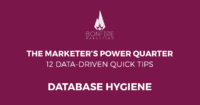One of the biggest buzzwords in marketing, and really across many industries, is artificial intelligence. For years, a majority of the public viewed AI as science fiction, but that’s starting to change. While many understand the impact AI could have on their future daily lives, most do not consider the minute effects AI has on their daily functions today—including marketers.
In 2018, AI’s adoption by marketing is undeniable. In fact, marketers who are not already using artificial intelligence in their digital marketing are behind the curve and quickly losing ground to competitors.
Digiday’s The State of Marketing in 5 Charts shows roughly half of surveyed marketing leaders are already using AI to:
- Improve targeting and efficiency in media buying.
- Tailor dynamic ads and landing pages for key audience segments.
- Deliver hyper-personalized content based on multiple data points.
- Empower marketer productivity and time savings.
Higher portions of marketing budgets are expected to be used on AI technologies in the near future, with eMarketer predicting AI spending to grow to roughly $28 billion by 2021, up from $6 billion in 2018.
So how can you or your organization begin implementing AI in digital marketing? Here are some easy ideas that start with popular ad platforms.
Automated bidding with AI in Google AdWords
If your organization is running PPC campaigns on Google, you’re likely already familiar with AdWords’ default setting for bidding strategy: Manual CPC. This method gives marketers the greatest control of the bidding strategy for each keyword. Combined with Google’s treasure trove of data on optimal bid amounts, it can be leveraged to provide great efficiency with any budget.
However, one of Manual CPC’s weaker points is its inability to be responsive and flexible during the keyword auction process. With marketers constantly changing bids and implementing new automated strategies, Manual CPC can consistently underperform compared to those strategies.
As an example, let’s say your campaign is set to Manual CPC, and you’ve placed a bid amount of $5.00 on a high-volume (and competitive) keyword. Your Quality Score for the keyword is 6/10, and you feel good about your odds of winning the auction and placing within the first three rankings. However, a series of competitors are placing bids on the same keyword, have a similar Quality Score as you, but are using automated strategies like Target ROAS and Maximize Conversions. These strategies notice the bid amount you’ve set, and automatically raise theirs based on the landscape of all bids for the target keyword. Now, the odds of winning are in their favor.
How easy is making the switch to an automated bidding strategy to let Google’s AI technology choose the best bids and audience on your behalf? Super simple. In the settings of an AdWords campaign, you’ll find bid strategy and all the choices available. Along with the above mentioned Target ROAS and Maximize Conversions, each automated strategy is unique and suited for different campaign strategies.
- Do you want your campaign to always try for top rankings or first page of results? Try Target Search Page Location.
- Looking to present your ads to users more likely to convert on your landing page? Try Maximize Conversions.
Using Maximize Conversions, we’ve seen clients significantly increase leads and improve CPLs the moment they switch. Just this year, a large construction software business saw leads increase 21 percent MoM and CPL decrease 47 percent MoM just by switching to automated bidding. What’s more, the quality of leads delivered to their sales team improved as well.
AI-generated ad and email copy
One of the newer AI technologies in marketing is the introduction of copywriting platforms for ads and emails. Copywriters are an integral part of any digital marketing campaign; their expertise in particular industries are an advantage over competitors without similar experts. And with these new AI copywriting platforms, copywriters now have one more tool at their disposal to create meaningful copy on a much larger scale.
These AI platforms can provide copywriters with the ability to quickly test numerous copy options for ads, emails, and even blogs. Traditionally, two versions of an ad are created to perform proper A/B testing and gain insightful results. With an AI platform, copywriters can now easily tweak and test many sets of ad copy in less time. By sharing previous ad copy and examples with these platforms, the AI powering them can begin mirroring new copy suggestions to match the tone and brand voice of a client. Similar platforms are also available for email subject lines and blogs.
Bonfire is currently testing a few of these platforms and can easily see their merits and the hype they’re getting. However, in many cases, these platforms have helped our copywriters more with ideation than actual copy they can use without significant rewriting. As always, new technologies have room for improvement. We expect these platforms to improve to become a staple of any copywriting team in the next few years.
Ad targeting on Facebook with custom/lookalike audiences
Facebook’s reach and intuitive ad platform make it one of the most powerful social media tools for advertisers. However, the same perks advertisers loved for years are now under scrutiny. Facebook’s recent ordeals with data privacy and collection on their platform are a hot topic in the industry, and advertisers now have to adapt.
One of the first key changes Facebook made was the removal of third-party targeting APIs; advertisers now have to use Facebook’s internal data for targeting. Additionally, Facebook will no longer provide the actual count of users in Custom Audiences and Lookalike Audiences.
Even with these changes, Custom and Lookalike Audiences are still strong options to target segments and users, along with performing ABM campaigns. With Custom Audiences, advertisers can provide Facebook with a list of users they would like to reach, and Facebook’s algorithm works to match the list with actual users. Although the match rate will rarely be 100 percent, the more data advertisers are able to provide, the stronger the match rate. Also, if advertisers create a Custom Audience based on users who visit one of their webpages, Facebook will try to mirror those users’ characteristics. One key note for advertisers: Make sure user consent has been gained when uploading a list into Facebook.
Lookalike Audiences are built from Custom Audiences, and can significantly expand the reach of any campaign. As the name implies, Lookalike Audiences work to find users who “look like” other users in the original Custom Audience. Facebook’s AI and machine learning algorithms find increasingly similar users, giving advertisers more targeted audiences for their campaigns. The combination of Custom and Lookalike audiences can be built without any original lists, creating an accessible point of entry for new marketers.
Implementing AI in marketing campaigns can be a daunting task for any organization, but there are a number of easy options to get you started. Platforms like Google and Facebook routinely add new AI and machine-learning processes, giving marketers powerful new tools to leverage these evolving technologies. While many more advanced AI tools beyond these do exist, the key to unlocking AI’s full potential is pairing it with current approaches like ABM campaigns, and with a creative team providing a human element—which will never go out of style.
Related resources
More Content
How to Create Personas With Google Analytics
Personas are critical for the success of your marketing efforts, digital or not. Strong personas are a reference for every department in your company or agency — from strategy to
The Marketer’s Power Quarter: Updating Lead Databases
This is the tenth in a 12-part series of quick-fix tips to improve your digital marketing results. Catch up on our last tip, and subscribe to our newsletter to get the
AI in Marketing: How to Get Started in 2018
One of the biggest buzzwords in marketing, and really across many industries, is artificial intelligence. For years, a majority of the public viewed AI as science fiction, but that’s starting




Leave A Comment